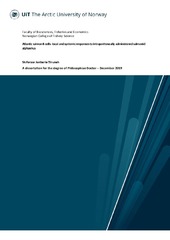| dc.contributor.advisor | Jensen, Ingvill | |
| dc.contributor.author | Jenberie, Shiferaw | |
| dc.date.accessioned | 2020-03-02T09:27:08Z | |
| dc.date.available | 2020-03-02T09:27:08Z | |
| dc.date.issued | 2020-03-04 | |
| dc.description.abstract | Viral diseases represent one of the major threats for salmonid aquaculture. Disease prevention by vaccination relies on the induction of protective antibody responses mediated by B-cells. Upon binding to a specific antigen during vaccination or infection, the B-cells become activated and mature into antibody secreting cells (ASC). The antibodies protect against re-infection and prevent spreading of the pathogen. The main goal of this thesis was to understand more of basic B-cell biology in Atlantic salmon (A.salmon) and study B-cell responses after in vitro stimulation and in vivo challenge experiments. Previously, the toll-like receptor (TLR) ligand CpG has demonstrated promising vaccine adjuvant activity in A. salmon. Here, CpG-stimulation of pure B-cells in culture enhanced secretion of IgM, suggesting CpG-mediated differentiation towards an ASC phenotype. A.salmon B-cells expressed nucleic acid sensing TLRs laying the basis for this stimulation. Infection by salmonid alphavirus (SAV3) causes pancreas disease in A.salmon. In this study, we used intraperitoneal (IP) infection with SAV3 as a model to characterize B-cell responses locally in the peritoneal cavity and in systemic immune tissues. IP-administration of vaccines is common in A. salmon and understanding the B-cell response in the peritoneal cavity is central. IP SAV3 infection induced peritoneal cavity B-cell responses as assessed by increased frequency of IgM+ B-cells and total IgM secreting cells (ASC). These responses were prolonged and positively correlated to anti-SAV3 antibody levels in serum. For the systemic immune sites, virus-induced changes in B-cell responses were modest. While live virus increased the levels of SAV3 specific ASCs both in the peritoneum and systemic immune sites, the response to IP-injected inactivated SAV3 in systemic sites was low and barely detectable. Collectively, the data indicate that A. salmon peritoneal cavity could serve as a peripheral immune site by providing a niche for maintenance of ASC responses. The thesis has provided basic knowledge about A.salmon B-cells and new methods for studying their function have been established. In addition, the importance of analyzing local B-cell responses is emphasized which calls for further exploration. | en_US |
| dc.description.doctoraltype | ph.d. | en_US |
| dc.description.popularabstract | Viral disease in Atlantic salmon is a major challenge for the aquaculture industry. Disease prevention by vaccination is dependent upon protective antibody responses produced by B cells. Upon binding to a virus during vaccination or infection, B cells are activated and mature into cells that secrete antibodies. While most vaccines used in aquaculture are injected into the abdominal cavity, there is little knowledge of B cell responses locally in the abdominal cavity and their significance for the vaccine effect. Salmonid alphavirus (SAV) causing pancreas disease in salmon, was used here to study the interplay between B cells locally in the abdominal cavity and in other immunological tissues. This thesis shows that SAV infection increases the number of B cells that secrete antibodies in the abdominal cavity, whereas in other immunological tissues, B cell responses are more limited. The thesis contributes to increased basic knowledge about B cells in salmon and new methods have been established to study B cell function in this species. In addition, the importance of analyzing local B cell responses during infection or vaccination is emphasized. Further research is needed to uncover the importance of local B cell responses for protective immunity. | en_US |
| dc.description.sponsorship | UiT The Arctic University of Norway
The Aquaculture Program of the Research Council of Norway (grants 237315/E40 and 254892/E40) | en_US |
| dc.identifier.isbn | 978-82-8266-177-5 | |
| dc.identifier.uri | https://hdl.handle.net/10037/17566 | |
| dc.language.iso | eng | en_US |
| dc.publisher | UiT The Arctic University of Norway | en_US |
| dc.publisher | UiT Norges arktiske universitet | en_US |
| dc.relation.haspart | <p>Paper I: Jenberie, S., Thim, H.L., Sunyer, J.O., Skjødt, K., Jensen, I. & Jørgensen, J.B. (2018). Profiling Atlantic salmon B cell populations: CpG-mediated TLR ligation enhances IgM secretion and modulates immune gene expression. <i>Scientific Reports, 8</i>, 3565. Also available in Munin at <a href=https://hdl.handle.net/10037/13446>https://hdl.handle.net/10037/13446</a>.
<p>Paper II: Jenberie, S., Peñaranda, M.D., Styrvold, M.B., Thim, H.L., Jørgensen, J.B. & Jensen, I. Salmonid alphavirus subtype 3 induces prolonged local B cell responses in peritoneal cavity of Atlantic salmon (<i>Salmo salar</i>) after intraperitoneal challenge. (Manuscript).
<p>Paper III: Jenberie, S., Nordli, H., Strandskog, G., Greiner-Tollersrud, L., Peñaranda, M.D., Jørgensen, J.B. & Jensen, I. Antigen specific antibody secreting cells reside in the peritoneal cavity and systemic sites of Atlantic salmon (<i>Salmo salar</i>) challenged intraperitoneally with salmonid alphavirus. (Manuscript). | en_US |
| dc.relation.isbasedon | Own laboratory data | en_US |
| dc.rights.accessRights | openAccess | en_US |
| dc.rights.holder | Copyright 2020 The Author(s) | |
| dc.subject.courseID | DOKTOR-002 | |
| dc.subject | VDP::Mathematics and natural science: 400::Basic biosciences: 470::General immunology: 478 | en_US |
| dc.subject | VDP::Matematikk og Naturvitenskap: 400::Basale biofag: 470::Generell immunologi: 478 | en_US |
| dc.subject | VDP::Agriculture and fishery disciplines: 900::Fisheries science: 920::Fish health: 923 | en_US |
| dc.subject | VDP::Landbruks- og Fiskerifag: 900::Fiskerifag: 920::Fiskehelse: 923 | en_US |
| dc.title | Atlantic salmon B cells- local and systemic responses to intraperitoneally administered salmonid alphavirus | en_US |
| dc.type | Doctoral thesis | en_US |
| dc.type | Doktorgradsavhandling | en_US |


 English
English norsk
norsk
